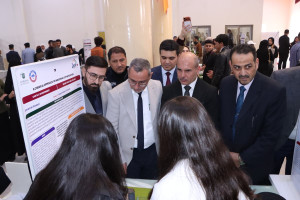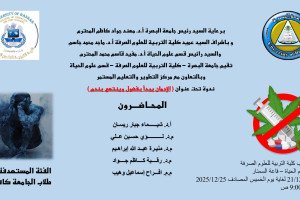
The College of Education for Pure Sciences at the University of Basrah discussed a PhD thesis on epidemiological monitoring and risk factors for hydatid disease in Dhi Qar Governorate
The thesis presented by the researcher (Afaq Taleb Farhoud) included
Epidemiological aspect Determining the prevalence rate and percentages of hydatid disease infections, its epidemiology, severity, and the relationship of infection with sex in infected human organs and intermediate hosts (sheep, cows, buffaloes, camels, and goats), slaughtered in the slaughterhouses of Dhi Qar Governorate, as well as studying the relationship between the sterility of some hydatid cysts and the type and gender of the host And the injured member and age group.
Molecular aspect: Determining the genotyping of the cysts of the parasite E. granulosus, and the common strains that cause hydatid cysts in humans and some intermediate hosts and among the different infected members of the same hosts in Dhi Qar Governorate using the polymerase chain reaction (PCR) method, as well as studying the variation Genes sequences of the strains Depending on the method of Multilocus sequence analysis (MLSA) using three mitochondrial genes together cox1, nad1 and atp6, and drawing a phylogenetic tree analysis of the sequence of the three genes together and comparing them using one gene, as well as verifying the effect of the haplotype on the process of sterility or degeneration of hydatid cysts The primary heads in it, and is there more than one genotype in the organ or host with multiple infection, and is the genotype related to the type of host?
Thesis concluded
The disease is endemic in Dhi Qar Governorate, and its infection rate and severity vary depending on the type, sex, and age group of the infected host, as well as the host's gender, type, infected organ, and age group are important factors that may contribute to the sterility of hydatid cysts.
Sheep (1G) and buffalo (3G) strains are responsible for the infections in Thi-Qar Governorate. The 1G sheep strain was dominant in 95% of the studied samples, and the 3G buffalo strain was recorded in only 5%.
Thesis recommended
Continuing scientific research and finding an effective vaccine to get rid of the parasite and kill it in the final host, or treatments that work to sterilize the hydatid cysts in intermediate hosts to interrupt its life cycle.
The genetic sequences recorded in this study and registered in the International Gen Bank (NCBI) can be relied upon as a reference source for comparison with future studies of Echinococcus granulomas in Iraq because it was one of the highest recorded sequences as well as different individual genotypes.
Relying on the MLSA method in future molecular studies. The study recommends the use of the complete or almost complete mitochondrial genome, or the use of high-sequence genes such as atp6 mt after it as a good partial molecular marker for diagnosing the strains of this parasite, as well as through which it is possible to know the different haplotypes within the strain.









